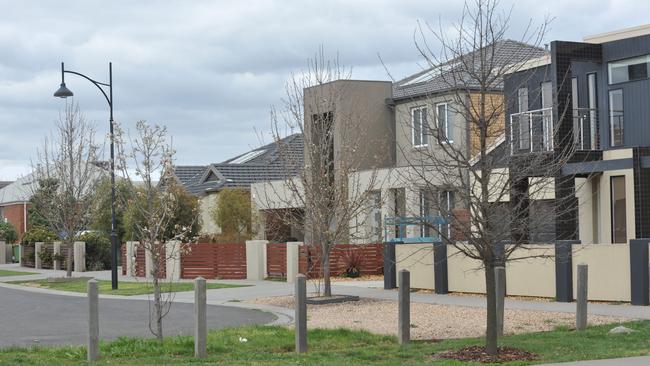Sandwich generation guide: How to juggle work, adult kids and ageing parents
They’re caught between the responsibilities of caring for ageing parents and adult children. And going can be tough for the “sandwich generation”.

VIC News
Don't miss out on the headlines from VIC News. Followed categories will be added to My News.
The sixth edition of the Australian Oxford Dictionary, released in 2017, included more than 2000 new words to reflect the evolution of the English language in the nation.
Alongside millennial newcomers such as “Insta” and “whatevs” was the “sandwich generation”, a term used to describe the group of people caught between the responsibilities of caring for ageing parents and adult children.
‘SANDWICH GENERATION’ CAUGHT IN THE FINANCIAL AND EMOTIONAL MIDDLE
THIS GENERATION OF AUSSIES IS THE LEAST SATISFIED
HOW TO KNOW YOU’RE A MILLENNIAL
The inclusion cemented what was social slang as a bona fide generational label.
Executive assistant Mary Devitsakis, 60, lives in Mount Waverley with husband Con.
Until recently, the household also included their youngest daughter who moved back after several years overseas.
Mrs Devitsakis takes time off work at least a couple of times a month to accompany her mother, 84, to a medical appointment, or to see her father who lives in an aged-care facility.
Her parents are Greek and speak little English, so she is often required as a translator and to be their key point of contact for doctors, banks and social clubs as well as handle their paperwork.

Mrs Devitsakis also takes every Wednesday off to look after her granddaughter, while her eldest daughter and husband are at work.
She is the first port of call for ad-hoc babysitting duties, too.
She is the filling in what some have begun calling the “Club Sandwich Generation”: a baby boomer with three generations of family requiring varying levels of support.
NUMBERS GROWING
A 2013 report put the number of Australians in the sandwich generation at more than 1.5 million, but social researcher Mark McCrindle estimates the figure is now much higher.
“It’s a growing group demographically because there’s an extension at both ends,” Mr McCrindle said.
“Their children are delaying independence because they might be in tertiary education, or house prices are preventing them from moving out, and their parents are not only living longer but living independently rather than going into aged care.
“As a result, that age bracket where you have kids needing care and parents needing care has expanded.”
A 2017 REST Industry Super report found this demographic is more likely to retire in debt, with one in three working Australians aged over 50 set to stop working before paying off their mortgage.
KIDS WANT THEIR INHERITANCES EARLY
THE TOUGH CHAT YOU NEED TO HAVE WITH YOUR FAMILY
Women in particular are feeling the impact on their health and mental wellbeing, according to a 2018 Jean Hailes for Women’s Health report, which found 67 per cent of the 15,000 Australians surveyed felt anxious or on edge almost every day.
Mrs Devitsakis said while her daughters are largely independent, and she cherishes the time she is able to spend with her granddaughter, the extra responsibilities associated with caring for her parents have taken their toll.
“It puts an enormous emotional strain on me because I am constantly worrying about something, or trying to be proactive in resolving issues and that ends up taking time away from my family,” she said.
“Financially it has obviously been a burden because I’ve had to reduce my days at work to look after my granddaughter, and that is something we felt was important to support my daughter as a new mother.
“There have been times where it’s got too much, and I’ve had a couple of meltdowns,” she said.

SEEK SUPPORT
Making use of the service industry is one way the sandwich generation is combating the issue of time pressure.
As people in their 40s and early 50s move into caretaker roles for their parents, they have shown they are not afraid to outsource solutions, Mr McCrindle said.
“Traditionally, it was one’s duty to help out the kids as required and the parents as required, and the idea of engaging a service to help Mum and Dad — calling an Uber to take them to the doctor, for example — would have been viewed pretty poorly,” he said.
“Gen X-ers are a bit different ... they have been shaped in an outsourced era, and they don’t see a problem with getting aged-care services, or using cleaners or arranging deliveries.
“They are still on board and involved and part of the solution, but they aren’t necessarily the ones driving around and delivering it.”
The advent of flexible working practices has also had a significant impact on this generation’s ability to care for family members, with Mrs Devitsakis saying, “I don’t know what I would have done” without the support of her employers.

But Mr McCrindle said improved access to clearer, more concise information — particularly around aged care and medical treatments — would better equip people to support their parents to grow old in their own home, or “age in place”.
Privacy, he argues, is another area of frustration for caregivers, who have to jump through hoops to access parents’ medical records or other important information required to make key decisions about their future.
“It makes it tricky to give parents advice because they can’t access all the information, so it would be helpful if there were ways of recognising this new life stage through channels of authority without having to be subjected to guardian-type approvals,” he said.
At the other end of the scale, parents with adult children still living at home should establish clear boundaries and avoid open-ended arrangements that could leave them feeling taken advantage of, or bring plans for retirement into uncertainty.
STAYING POSITIVE
Despite these challenges, Mr McCrindle said the most noticeable development during the past five years has been the shifting attitudes towards the sandwich generation.
“Initially the tone of the conversation was quite negative — ‘the sandwich generation doing it tough’ — but now, I think more people are seeing it as a reality of a developed society where people are healthier for longer and can remain in their homes later in life,” he says.
But Mrs Devitsakis maintains she won’t be passing on the baton to either of her daughters if she can help it.
“It was always expected of me, but I’ve been my parents’ eyes and ears since I was 10 years old, and that is a long time for someone to be relying on you,” she said.
“Of course I hope my husband and I are in a position where we can look after each other for as long as possible, but I have no expectations that my kids will make the same sacrifices that I have.”
SUBURBAN HOT SPOTS FOR DOWNSIZING SENIORS
Baby boomers are driving Australia’s property markets, with more than one million homeowners planning to downsize in the next five years, a Herron Todd White report has found.
Australia’s top 10 list of most popular suburbs for downsizers included Melbourne’s CBD at No.9, but the report also found cultural affiliations and coastal lifestyles are driving demand well beyond Zone 1.
EAST: HAWTHORN, CAMBERWELL
The report found Boroondara’s baby boomers are staying put, with downsizers in the eastern suburbs driven by a desire to maintain established connections with their community.
Jellis Craig Hawthorn director Richard Earle said the local market is dominated by buyers who have spent “the happiest years of their lives” raising families in the area and have no desire to leave.
“They want the same parks, the same shops, the same transport that they’ve always had, but they’re also getting used to higher-density living,” Mr Earle said.
Developers are responding with luxurious but low-maintenance townhouses and boutique developments of up to 10 apartments.
Demand for duplex townhouses and units is also rising in bayside suburbs such as Sandringham and Black Rock, with developers noting a significant number of buyers arriving from the east.
NORTH: CRAIGIEBURN, MERNDA
Downsizing is almost a dirty word in the outer north, where seniors are investing their more established nest eggs into larger properties, according to Craigieburn Real Estate City director Vic Spano Jr.
The HTW report flagged a strong market for retirees in Craigieburn, Mickleham, Wollert and Mernda as buyers can buy medium-sized dwellings on generous blocks for an affordable price. Many are first and second-generation migrants who settled in the area and want to stay close to their families.

“In the last couple of years we’ve seen a lot of interest in the much larger properties for multi-generational households,” Mr Spano said.
“We have five or six on our books at the moment, most of them four- or five-bedroom properties with the master on the ground floor for the ageing parents.”
SOUTHEAST: MORNINGTON, HASTINGS
Mornington Peninsula’s established coastal townships have always been popular among those looking to retire by the beach, but the rise of the “lifestyle community” has turned suburbs such as Hastings into a hub for pre-retirees.
Residents of a lifestyle community own their home and enter into a lease on the land; in retirement villages contracts are either a strata title or leasehold and relate to the building.
Developer Lifestyle Communities has two villages in the southeast, and managing director James Kelly said the average age of buyers is 67, which is well over a decade younger than the average person buying into a retirement village.
“Some homeowners in a Lifestyle Community are still working or working part time, so are looking to live a totally independent lifestyle in a resort-style community,” Mr Kelly said.
A key selling point for Lifestyle Hastings is its proximity to the peninsula and Melbourne via the freeway, a boon for those still working in town.
FOR MORE STORIES ON RETIREMENT LIVING, LOOK OUT FOR LIVING+ MAGAZINE IN SATURDAY’S HERALD SUN.
Originally published as Sandwich generation guide: How to juggle work, adult kids and ageing parents


